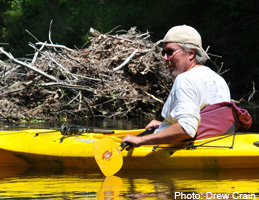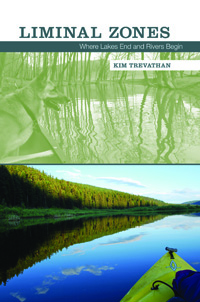Once More from the Lake
Kim Trevathan paddles upstream in search of transitions between flooded and natural rivers
In Liminal Zones: Where Lakes End and Rivers Begin Kim Trevathan chronicles his kayak and canoe journeys upstream from flatwater, current-less lakes and reservoirs to places where rivers rise above the flooding and come alive. It’s an elastic theme, allowing Trevathan, an assistant professor of writing at Maryville College, to range over a variety of writing types, from a straightforward, journal-style narrative to passages of both lyrical and gritty description, not only of the landscape but also of the people he encounters: campers, fishermen, river guides, and bystanders. His theme also leads to reflections on the meaning and role of rivers historically, spiritually, and culturally, and how unintended consequences often accompany tinkering in the name of progress.
 Most of the lakes and reservoirs Trevathan paddles are the result of dams intended for power generation, flood control, and recreation, but a few—coastal lagoons, as well as one glacially-formed lake—are themselves natural. And there are many variants even among the human-dammed: some relatively benign dams do little more than preserve wetlands in dry years; others have completely destroyed the ecology of huge areas.
Most of the lakes and reservoirs Trevathan paddles are the result of dams intended for power generation, flood control, and recreation, but a few—coastal lagoons, as well as one glacially-formed lake—are themselves natural. And there are many variants even among the human-dammed: some relatively benign dams do little more than preserve wetlands in dry years; others have completely destroyed the ecology of huge areas.
The narrative of Trevathan’s adventures is engaging. He capsizes in the Rogue River in Oregon and nearly drowns. He worries about alligators in coastal South Carolina. The Pigeon River, while somewhat improved in recent years, still leaves a paddler’s clothes carrying a chemical stink. Trevathan decides to try night paddling and relates the difficulties and rewards. He sometimes stops to fish. Sometimes he gets lost. Camping is frequently accompanied by campground dramas. While Trevathan’s paddling is mostly solo, on several ventures he has company from a faculty colleague, his initially reluctant and water-fearing German Shepherd, or his niece.
 Liminal Zones is much more than an adventure narrative, however. In describing the rivers and landscape he’s experiencing, Trevathan makes a number of literary references, particularly to the writings of John Muir, and he acknowledges the paradox of much nature writing: in conveying the beauty of wild spaces, such books risk inspiring hordes to join their authors in the woods: “I was willing to share the sublime with others, though it was true I didn’t want to see it overrun with visitors like me,” he writes. The book raises some significant questions. What makes one place worthy of preservation and another open for development? Why do some landscapes imprint themselves on memory while others slip away, unrecorded? What exactly is a “beautiful” landscape?
Liminal Zones is much more than an adventure narrative, however. In describing the rivers and landscape he’s experiencing, Trevathan makes a number of literary references, particularly to the writings of John Muir, and he acknowledges the paradox of much nature writing: in conveying the beauty of wild spaces, such books risk inspiring hordes to join their authors in the woods: “I was willing to share the sublime with others, though it was true I didn’t want to see it overrun with visitors like me,” he writes. The book raises some significant questions. What makes one place worthy of preservation and another open for development? Why do some landscapes imprint themselves on memory while others slip away, unrecorded? What exactly is a “beautiful” landscape?
“What constituted the sublime was part of what drove me on this quest,” Trevathan writes, “and articulating what physical dimensions, what history, what confluences of time and place produced it was complex and in no way an exact formula.” As he discovers, the sublime is a subjective and moving target, like liminal zones themselves, which move up or down stream depending on the level of the lake.


